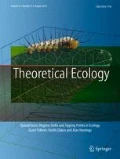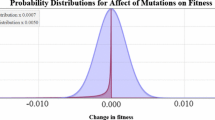Abstract
A central model in theoretical ecology considers the competition of a range of species for a broad spectrum of resources. Recent studies have shown that essentially two different outcomes are possible. Either the species surviving competition are more or less uniformly distributed over the resource spectrum, or their distribution is “lumped” (or “clumped”), consisting of clusters of species with similar resource use that are separated by gaps in resource space. Which of these outcomes will occur crucially depends on the competition kernel, which reflects the shape of the resource utilization pattern of the competing species. Most models considered in the literature assume a Gaussian competition kernel. This is unfortunate, since predictions based on such a Gaussian assumption are not robust. In fact, Gaussian kernels are a border case scenario, and slight deviations from this function can lead to either uniform or lumped species distributions. Here, we illustrate the non-robustness of the Gaussian assumption by simulating different implementations of the standard competition model with constant carrying capacity. In this scenario, lumped species distributions can come about by secondary ecological or evolutionary mechanisms or by details of the numerical implementation of the model. We analyze the origin of this sensitivity and discuss it in the context of recent applications of the model.



Similar content being viewed by others
References
Abrams P (1983) The theory of limiting similarity. Ann Rev Ecolog Syst 14:359–376
Ackermann M, Doebeli M (2004) Evolution of niche width and adaptive diversification. Evolution 58(12):2599-2612
Baptestini EM, De Aguiar MAM, Bolnick DI, Araújo MS (2009) The shape of the competitition and carrying capacity kernels affects the likelihood of disruptive selection. J Theor Biol. doi:10.1016/j.tbi.2009.02.023
Barabás G, Meszéna G (2009) When the exception becomes the rule: the disappearance of limiting similarity in the LotkaVolterra model. J Theor Biol 258(1):89–94
Case TJ (1981) Niche packing and coevolution in competition communities. Proc Natl Acad Sci U S A 78(8):5021–5025
Chesson P, Kuang JJ (2008) The interaction between predation and competition. Nature (456):235–238
Doebeli M, Dieckmann U (2000) Evolutionary branching and sympatric speciation caused by different types of ecological interactions. Am Nat 156(4):77–101
Doebeli M, Blok HJ, Leimar O, Dieckmann U (2007) Multimodal pattern formation in phenotype distributions of sexual populations. Proc R Soc Lond B 274(1608):347–357
Fort H, Scheffer M, Van Nes EH (2009) The paradox of clumps mathematically explained. Theor Ecol. doi:10.1007/s12080-009-0040-x
Haccou P, Iwasa Y (1995) Optimal mixed strategies in stochastic environments. Theor Popul Biol 47:212–243
Hernández-García E, Pigolotti S, Lopez C, Andersen KH (2009) Species competition: coexistence, exclusion and clustering. Phil Trans R Soc A 367:3183–3195
Johansson J, Ripa J (2006) Will sympatric speciation fail due to stochastic competitive exclusion? Am Nat 168(4):572–578
Kubo T, Iwasa Y (1996) Phenological pattern of tree regeneration in a model for forest species diversity. Theor Popul Biol 49:90–117
Lawson DJ, Jensen HJ (2007) Neutral evolution in a biological population as diffusion in phenotype space: reproduction with local mutation but without selection. Phys Rev Lett 98:098102
Leimar O, Doebeli M, Dieckmann U (2008) Evolution of phenotipic clusters through competition and local adaptation along an environmental gradient. Evolution. doi:10.1111/j.1558-5646.2008.00334.x
Levins R (1968) Evolution in changing environments. Princeton University Press, Princeton
Lewis H, Law R (2007) Effects of dynamic on ecological networks. J Theor Biol 247:64–76
Loeuille N, Loreau M (2005) Evolutionary emergence of size-structured food webs. Proc Natl Acad Sci USA 102(16): 5761–5766
MacArthur R, Levins R (1967) The limiting similarity, convergence, and divergence of coexisting species. Am Nat 101(921):377–385
May R, MacArthur RH (1972) Niche overlap as a function of environmental variability. Proc Natl Acad Sci USA 69(5):1109–1113
May R, Crawley JC, Sugihara G (2007) Communities: patterns. In: May R, McLean A (eds) Theoretical ecology. Oxford University Press, Cambridge
Meszéna G, Gyllenberg M, Pésztor Metz AJ (2006) Competitive exclusion and limiting similarity: a unified theory. Theor Popul Biol 69:68–87
Pigolotti S, Lopez C, Hernández-García E (2007) Species clustering in competitive Lotka–Volterra models. Phys Rev Lett 98:258101
Roughgarden J (1979) Theory of population genetics and evolutionary ecology: an introduction. Macmillan, London
Sasaki A, Ellner E (1995) The evolutionary stable strategy in fluctuating environments. Evolution 49:337–350
Scheffer M, van Nes EH (2006) Self-organized similarity, the evolutionary emergence of groups of similar species. Proc Natl Acad Sci USA 103(16):6230–6235
Schoener TW (1974) Some methods for calculating competition coefficients from resource-utilization spectra. Am Nat 108(961):332–340
Szabó P, Meszéna G (2006) Limiting similarity revisited. Oikos 112(3):612–619
Turelli M (1978) Does environmental variability limit niche overlap? Proc Natl Acad Sci USA 75(10):5085–5089
Wilson DS (1975) The adequacy of body size as a niche difference. Am Nat 109(970):769–784
Acknowledgements
C.L. and E.H-G. acknowledge support from project FISICOS (FIS2007-60327) of MEC and FEDER and NEST-Complexity project PATRES (043268). K.H.A was supported by the Danish research council, grant no. 272-07-0485
Author information
Authors and Affiliations
Corresponding author
Rights and permissions
About this article
Cite this article
Pigolotti, S., López, C., Hernández-García, E. et al. How Gaussian competition leads to lumpy or uniform species distributions. Theor Ecol 3, 89–96 (2010). https://doi.org/10.1007/s12080-009-0056-2
Received:
Accepted:
Published:
Issue Date:
DOI: https://doi.org/10.1007/s12080-009-0056-2




